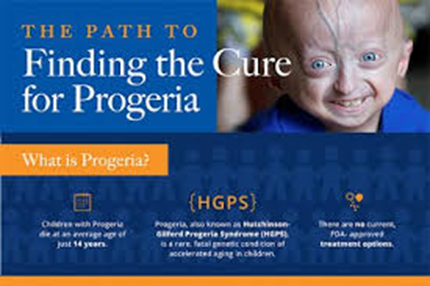Progeria
Overview
Progeria (pro-JEER-e-uh),
also known as Hutchinson-Gilford syndrome, is an extremely rare, progressive
genetic disorder that causes children to age rapidly, starting in their first
two years of life.
Children with progeria generally
appear normal at birth. During the first year, signs and symptoms, such as slow
growth and hair loss, begin to appear.
Heart problems or strokes
are the eventual cause of death in most children with progeria. The average
life expectancy for a child with progeria is about 13 years. Some with the
disease may die younger and others may live longer, even up to 20 years.
There's no cure for
progeria, but ongoing research shows some promise for treatment.
Usually within the first
year of life, growth of a child with progeria slows markedly, but motor
development and intelligence remain normal.
Signs and symptoms of this
progressive disorder include a distinctive appearance:
Slowed growth, with
below-average height and weight
Narrowed face, small lower
jaw, thin lips and beaked nose
Head disproportionately
large for the face
Prominent eyes and
incomplete closure of the eyelids
Hair loss, including
eyelashes and eyebrows
Thinning, spotty, wrinkled
skin
Visible veins
High-pitched voice
Signs and symptoms also
include health issues:
Severe progressive heart and
blood vessel (cardiovascular) disease
Hardening and tightening of
skin on the trunk and extremities (similar to scleroderma)
Delayed and abnormal tooth
formation
Some hearing loss
Loss of fat under the skin
and loss of muscle mass
Skeletal abnormalities and
fragile bones
Stiff joints
Hip dislocation
Insulin resistance
When to see a doctor
Progeria is usually detected
in infancy or early childhood, often at regular checkups, when a baby first
shows the characteristic signs of premature aging.
If you notice changes in
your child that could be signs and symptoms of progeria, or you have any
concerns about your child's growth or development, make an appointment with
your child's doctor.
Causes
A single gene mutation is
responsible for progeria. The gene, known as lamin A (LMNA), makes a protein
necessary for holding the center (nucleus) of a cell together. When this gene
has a defect (mutation), an abnormal form of the lamin A protein called
progerin is produced and makes cells unstable. This appears to lead to
progeria's aging process.
Unlike many genetic
mutations, progeria is rarely passed down in families. The gene mutation is a
rare, chance occurrence in the majority of cases.
Other similar
syndromes
There are other progeroid
syndromes that do run in families. These inherited syndromes cause rapid aging
and a shortened life span:
Wiedemann-Rautenstrauch
syndrome, also known as neonatal progeroid syndrome, starts in the womb, with
signs and symptoms of aging apparent at birth.
Werner syndrome, also known
as adult progeria, begins in the teen years or early adulthood, causing
premature aging and conditions typical of old age, such as cataracts and
diabetes.
Risk factors
There are no known factors,
such as lifestyle or environmental issues, which increase the risk of having
progeria or of giving birth to a child with progeria. Progeria is extremely
rare. For parents who have had one child with progeria, the chances of having a
second child with progeria are about 2 to 3 percent.
Complications
Children with progeria
usually develop severe hardening of the arteries (atherosclerosis). This is a
condition in which the walls of the arteries — blood vessels that carry
nutrients and oxygen from the heart to the rest of the body — stiffen and
thicken, often restricting blood flow.
Most children with progeria
die of complications related to atherosclerosis, including:
Problems with blood vessels
that supply the heart (cardiovascular problems), resulting in heart attack and
congestive heart failure
Problems with blood vessels
that supply the brain (cerebrovascular problems), resulting in stroke
Other health problems
frequently associated with aging — such as arthritis, cataracts and increased
cancer risk — typically do not develop as part of the course of progeria.
Jan Ricks Jennings, MHA,
LFACHE
Senior Consultant
Senior Management Resources,
LLC
JanJenningsBlog.Blogspot.com
412.913.0636 Cell
724.733.0509 Office
February 28, 2022




No comments:
Post a Comment